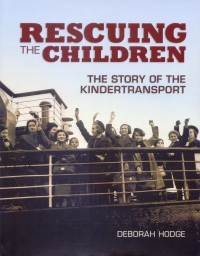| ________________
CM . . . . Volume XIX Number 5 . . . . October 5, 2012
excerpt:
Rescuing the Children is a succinct history of the Kindertransport rescue operations that saw almost ten thousand Jewish children evacuated from Germany, Austria, Czechoslovakia and the Free City of Danzig (now Gdansk, Poland) to Great Britain between December, 1938, and the start of World War II on September 1, 1939, when the German border was closed. Also included are accounts of Jewish children who found temporary safety in an orphanage in Amsterdam but then fled to England aboard the Dutch freighter SS Bodegraven on May 14, 1940, just hours before the government of Holland surrendered to the German occupiers. Hodge, a former elementary school teacher and curriculum writer for the B.C. Ministry of Education, has written some twenty-five works of nonfiction for children. In recounting this challenging historical event and in order to add an individual human scale to the subject, Hodge uses brief quotes and anecdotes from five women and three men who escaped from Germany as nine to fourteen-year-old children. These quotes are set apart from the regular text in boxes with clear headings such as “Norbert’s Story.” The text includes a two page glossary or “Words to Know” yet many of these terms are already explained in the text, often within parentheses, as illustrated in the excerpt. A map, timeline from 1933 to 1946, note to parents and teachers consisting chiefly of selected resources for children and for adults including important websites, and surprisingly even an index round out the features of the book. Teachers should be aware that Hodge also has created a useful nine-page teacher’s guide with suggested activities that can be easily found on her personal website. The work sets the context with rising persecution of Jews in Germany during the 1930s that reached a new height on November 8 and 9, 1938, when a concerted plan of Nazi violence led to a violent rampage against Jewish homes, schools, synagogues, cemeteries, and businesses throughout Germany, Austria, and the Sudetenland (part of Czechoslovakia) that is known as Kristallnacht or the Night of Broken Glass. The failure of countries around the world to help provide safe haven for Jewish people in the light of persecution is explained, in part, by the economic concerns of potential host countries suffering from the Depression, and by Anti-Semitism that was commonplace. However, the glad news of this volume is that individuals, organizations and the government of Great Britain obtained Nazi permission to evacuate Jewish children under the age of seventeen. Most of the evacuated infants, children and teenagers were relocated to foster homes or group homes, orphanages, hostels or boarding schools in Great Britain, although some were left with relatives or in care in Holland. Hodge describes the registration process, preparations, the ability of parents to part with their children who often were told only that they were going on a holiday and would be joined shortly by their families, the actual train trips through German-controlled lands and Holland followed by boat travel to England. Several significant leaders in the rescue are profiled, including the Quaker Bertha Bracey and London stockbroker Nicholas Winton who was the first to organize rescue missions from Czechoslovakia. Life in Britain, efforts to stay in touch with family during the war years, and life after the war are all wrapped up in a few pages. The eight survivors and Irene N. Watts, whose story is provided in the Foreword, are all reintroduced near the end of the book with recent photographs, news on their lives as adults and brief advice for children today. Reunions and memorials are also briefly discussed. Significantly, Rescuing the Children is extensively illustrated with contemporary photographs, paintings and drawings by Hans Jackson who escaped to England in 1939 when he was 18, and with panels from the five Kindertransport memorial quilts sewn by Kirsten Grosz and displayed at the Holocaust Memorial Center in Farmington Hills, Michigan. Hodge notes:
Rescuing the Children will be a useful tool to assist in educating youngsters about a sad piece of human history that had a life-saving chapter for thousands of Jewish children. Recommended. Val Ken Lem is a librarian at Ryerson University in Toronto, ON, with liaison duties in History, English and Caribbean Studies.
To comment
on this title or this review, send mail to cm@umanitoba.ca.
Copyright © the Manitoba Library Association. Reproduction for personal
use is permitted only if this copyright notice is maintained. Any
other reproduction is prohibited without permission.
NEXT REVIEW |
TABLE OF CONTENTS FOR THIS ISSUE
- October 5, 2012.
AUTHORS |
TITLES |
MEDIA REVIEWS |
PROFILES |
BACK ISSUES |
SEARCH |
CMARCHIVE |
HOME |
